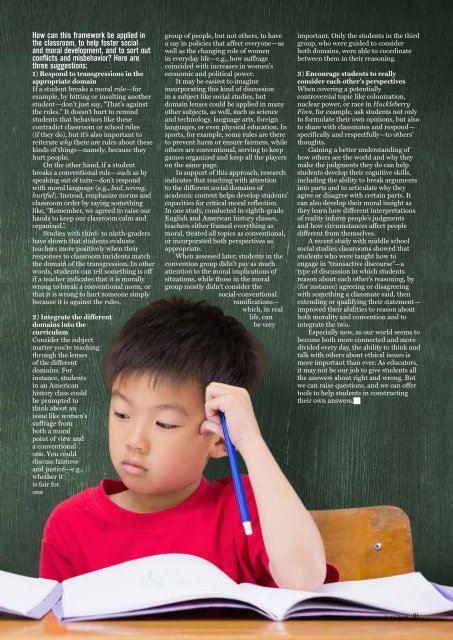Oi Magazine reviews - Aura & Co. Infrared Sauna Studio,Thao Dien... "Heavenly Heat"
You also want an ePaper? Increase the reach of your titles
YUMPU automatically turns print PDFs into web optimized ePapers that Google loves.
How can this framework be applied in<br />
the classroom, to help foster social<br />
and moral development, and to sort out<br />
conflicts and misbehavior? Here are<br />
three suggestions:<br />
1) Respond to transgressions in the<br />
appropriate domain<br />
If a student breaks a moral rule—for<br />
example, by hitting or insulting another<br />
student—don’t just say, “That’s against<br />
the rules.” It doesn’t hurt to remind<br />
students that behaviors like these<br />
contradict classroom or school rules<br />
(if they do), but it’s also important to<br />
reiterate why there are rules about these<br />
kinds of things—namely, because they<br />
hurt people.<br />
On the other hand, if a student<br />
breaks a conventional rule—such as by<br />
speaking out of turn—don’t respond<br />
with moral language (e.g., bad, wrong,<br />
hurtful). Instead, emphasize norms and<br />
classroom order by saying something<br />
like, “Remember, we agreed to raise our<br />
hands to keep our classroom calm and<br />
organized.”<br />
Studies with third- to ninth-graders<br />
have shown that students evaluate<br />
teachers more positively when their<br />
responses to classroom incidents match<br />
the domain of the transgression. In other<br />
words, students can tell something is off<br />
if a teacher indicates that it is morally<br />
wrong to break a conventional norm, or<br />
that it is wrong to hurt someone simply<br />
because it is against the rules.<br />
2) Integrate the different<br />
domains into the<br />
curriculum<br />
<strong>Co</strong>nsider the subject<br />
matter you’re teaching<br />
through the lenses<br />
of the different<br />
domains. For<br />
instance, students<br />
in an American<br />
history class could<br />
be prompted to<br />
think about an<br />
issue like women’s<br />
suffrage from<br />
both a moral<br />
point of view and<br />
a conventional<br />
one. You could<br />
discuss fairness<br />
and justice—e.g.,<br />
whether it<br />
is fair for<br />
one<br />
group of people, but not others, to have<br />
a say in policies that affect everyone—as<br />
well as the changing role of women<br />
in everyday life—e.g., how suffrage<br />
coincided with increases in women’s<br />
economic and political power.<br />
It may be easiest to imagine<br />
incorporating this kind of discussion<br />
in a subject like social studies, but<br />
domain lenses could be applied in many<br />
other subjects, as well, such as science<br />
and technology, language arts, foreign<br />
languages, or even physical education. In<br />
sports, for example, some rules are there<br />
to prevent harm or ensure fairness, while<br />
others are conventional, serving to keep<br />
games organized and keep all the players<br />
on the same page.<br />
In support of this approach, research<br />
indicates that teaching with attention<br />
to the different social domains of<br />
academic content helps develop students’<br />
capacities for critical moral reflection.<br />
In one study, conducted in eighth-grade<br />
English and American history classes,<br />
teachers either framed everything as<br />
moral, treated all topics as conventional,<br />
or incorporated both perspectives as<br />
appropriate.<br />
When assessed later, students in the<br />
convention group didn’t pay as much<br />
attention to the moral implications of<br />
situations, while those in the moral<br />
group mostly didn’t consider the<br />
social-conventional<br />
ramifications—<br />
which, in real<br />
life, can<br />
be very<br />
important. Only the students in the third<br />
group, who were guided to consider<br />
both domains, were able to coordinate<br />
between them in their reasoning.<br />
3) Encourage students to really<br />
consider each other’s perspectives<br />
When covering a potentially<br />
controversial topic like colonization,<br />
nuclear power, or race in Huckleberry<br />
Finn, for example, ask students not only<br />
to formulate their own opinions, but also<br />
to share with classmates and respond—<br />
specifically and respectfully—to others’<br />
thoughts.<br />
Gaining a better understanding of<br />
how others see the world and why they<br />
make the judgments they do can help<br />
students develop their cognitive skills,<br />
including the ability to break arguments<br />
into parts and to articulate why they<br />
agree or disagree with certain parts. It<br />
can also develop their moral insight as<br />
they learn how different interpretations<br />
of reality inform people’s judgments<br />
and how circumstances affect people<br />
different from themselves.<br />
A recent study with middle school<br />
social studies classrooms showed that<br />
students who were taught how to<br />
engage in “transactive discourse”—a<br />
type of discussion in which students<br />
reason about each other’s reasoning, by<br />
(for instance) agreeing or disagreeing<br />
with something a classmate said, then<br />
extending or qualifying their statement—<br />
improved their abilities to reason about<br />
both morality and convention and to<br />
integrate the two.<br />
Especially now, as our world seems to<br />
become both more connected and more<br />
divided every day, the ability to think and<br />
talk with others about ethical issues is<br />
more important than ever. As educators,<br />
it may not be our job to give students all<br />
the answers about right and wrong. But<br />
we can raise questions, and we can offer<br />
tools to help students in constructing<br />
their own answers.<br />
OI VIETNAM<br />
91





